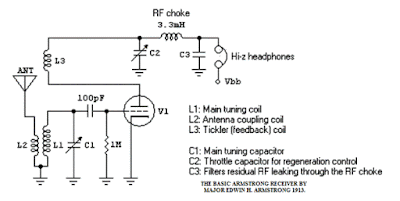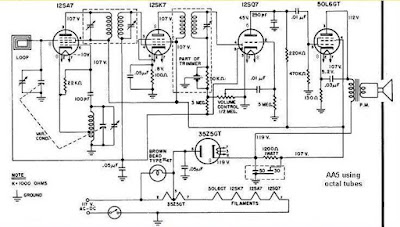For quite sometime, octal tubes was standard until the minis came out, the 7 pin tubes, then of course the 9 pin tubes. The 6SA7, 6SK7, 6AQ7 and the power amp were replaced by the minis 6BE6,BA6,AV6, an the 50C5. If you have the RCA tube manual, they no longer show the octal version.
Now, if we analyze the circuit, we actually do a hybrid and eliminate the power amp and use an IC amp. Secondly, we will not need the pre amp in the AQ6 since the IC amp is sensitive enough. If not, a tranny will boost the signal. /Thirdly, we do not need a tube diode. A 1n34 will work. I have done this. And the best news is that we won't need the recgifier tube as the RF tubes can work on even 12 volts as well as the IC.
WHAT IT MEANS WE ONLY NEED THE FIRST 2 TUBES! If you have the octals, nice and nostalgic. If none the BE6 and the BA6 will do. 6 olt or 12 volt filament will be ok.
If we need to raise the B+, we can do a voltage doubler. A 1 amp main traffo will do. 12 V will have the advantage of having a higher secondary available.
Now, the rare parts these days are the variable capacitor,the old open type. Next is a pair of IF transformers. There is a DIY instruction in the web. The the 2 coils, the antenna coil and the oscillator coil. They can be home made too. Actually ceramic filters can be used. There are gthousands of IF traffos all over the country, we just don't know where they are. Even some old stores in Raon may have them.
I intend to experiment with the small IFT's used in transistor radios. I have a Zenith AA5 and the antenna coil i modern and is wrapped in a ferrite bar whic can be easily copied.
There is as a last resort a neat trick to make a tuner. Use a rotary switch. since we need 2 ganged switches, the max available is a 6 position double pole SW. We can "channelize" 6 favorite MW stations. Each position chooses a capacitor for the antenna and the osc coil. Parallel to the capacitor is a trimmer. So, the stations are pre-set. If we wan 12 channels, we just externally gang a Single pole, 12 throw rotary SW.
Regen circuit
Description. In 1913 Major Edwin H. Armstrong patented a design for the Regenarative Receiver that uses the principle of positive feed-back in amplifiers to demodulate AM, CW, SSB, and FM. Mr. Armstrong's circuit is shown and used the new vacuum tube of the time. The Regenerative receiver has since become the most popular basic receiver for Amateur Radio Operators and Electronics experimenters worldwide. The principle of operation is simple. Positive RF feedback is used to increase the RF gain of the amplifier up to and beyond self-oscillation. With no input RF signal the internal noise peaks and a small bias voltage combine to produce a stable but self-limiting oscillator, except right at the peak of oscillation very high gain is produced and the detector becomes very sensitive to small input RF signals, like those associated with SSB and CW. AM is demodulated just below the point of oscillation, but SSB and CW are demodulated when an RF signal combines with the heterodyne sign...


Comments
Post a Comment